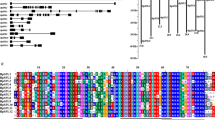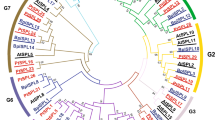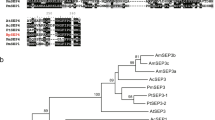Abstract
Key message
BplSPL1 gene was identified in Betula platyphylla Suk, and its sequence features and gene function expression have provided useful information for further studies on function.
Abstract
SQUAMOSA promoter-binding protein-like (SPL) are plant-specific transcription factors that play an important regulatory role in plant growth and development. In this study, an SPL gene, BplSPL1, was cloned from Betula platyphylla Suk. (white birch). Sequence analysis revealed that BplSPL1 has a 405 bp open reading frame (ORF) and encodes a protein of 134 amino acids, which contains a highly conserved SQUAMOSA promoter-binding protein (SBP) domain belonging to the SPL family. Quantitative RT-PCR analysis showed that BplSPL1 was more highly expressed in mature leaf as well as male and female inflorescences. The ectopic expression of BplSPL1 in Arabidopsis led to early flowering, reduced number of rosette leaves, and increased number of lateral branches. We also found that plant height of the transgenic plants decreased, and length of the siliques was shorter in the 35S::BplSPL1 transgenic plants. Further studies showed that the early-flowering phenotype in 35S::BplSPL1 transgenic plants was related to changes in the expression of flowering time genes and flower meristem identity genes, including CUC, FUL, DCL, and SOC1. Therefore, the above results indicate that: (1) BplSPL1 may be involved in regulating flowering time and phase transition, and (2) BplSPL1 may interact with other genes to regulate plant height and the development of lateral branches and fruit.






Similar content being viewed by others
References
Aida M, Tasaka M (2006) Morphogenesis and patterning at the organ boundaries in the higher plant shoot apex u. Plant Mol Biol 60(6):915–928
Aida M, Ishida T et al (1997) Genes involved in organ separation in Arabidopsis: an analysis of the cup-shaped cotyledon mutant. Plant Cell 9(6):841–857
Alvarez-Buylla ER, Benitez M et al (2010) Flower development. The Arabidopsis Book 8:e0127
Aukerman MJ, Sakai H (2003) Regulation of flowering time and floral organ identity by a microRNA and its APETALA2-like target genes. Plant Cell 15(11):2730–2741
Aung B, Gruber MY et al (2015) Ectopic expression of LjmiR156 delays flowering, enhances shoot branching, and improves forage quality in alfalfa. Plant Biotechnol Rep 9(6):379–393
Bartel B, Bartel DP (2003) MicroRNAs: at the root of plant development? Plant Physiol 132(2):709–717
Cardon GH, Hohmann S et al (1997) Functional analysis of the Arabidopsis thaliana SBP-box gene SPL3: a novel gene involved in the floral transition. Plant J 12(2):367–377
Chang S, Puryear J et al (1993) A simple and efficient method for isolating RNA from pine trees. Plant Mol Biol Rep 11(2):113–116
Chuck G, Cigan AM et al (2007) The heterochronic maize mutant Corngrass1 results from overexpression of a tandem microRNA. Nat Genet 39(4):544–549
Clough SJ, Bent AF (1998) Floral dip: a simplified method for Agrobacterium-mediated transformation of Arabidopsis thaliana. The Plant J 16(6):735–743
Eriksson EM, Bovy A et al (2004) Effect of the Colorless non-ripening mutation on cell wall biochemistry and gene expression during tomato fruit development and ripening. Plant Physiol 136(4):4184–4197
Gandikota M, Birkenbihl RP et al (2007) The miRNA156/157 recognition element in the 3′ UTR of the Arabidopsis SBP box gene SPL3 prevents early flowering by translational inhibition in seedlings. Plant J 49(4):683–693
Han Y, Ma Y et al (2016) Characterization and phylogenetic analysis of fifteen NtabSPL genes in Nicotiana tabacum L. cv. Qinyan95. Dev Genes Evol 226(1):1–14
Hou X, Zhou J et al (2014) Nuclear factor Y-mediated H3K27me3 demethylation of the SOC1 locus orchestrates flowering responses of Arabidopsis. Nat Commun 5:4601
Hyun Y, Richter R et al (2016) Multi-layered Regulation of SPL15 and Cooperation with SOC1 Integrate Endogenous Flowering Pathways at the Arabidopsis Shoot Meristem. Dev Cell 37(3):254–266
Hyun Y, Richter R et al (2017) Competence to flower: age-controlled sensitivity to environmental cues. Plant Physiol 173(1):36–46
Jack T (2004) Molecular and genetic mechanisms of floral control. Plant Cell 16S:S1–S17
Jiao Y, Wang Y et al (2010) Regulation of OsSPL14 by OsmiR156 defines ideal plant architecture in rice. Nat Genet 42(6):541-U36
Jung J, Seo Y et al (2007) The GIGANTEA-regulated MicroRNA172 mediates photoperiodic flowering independent of CONSTANS in Arabidopsis. Plant Cell 19(9):2736–2748
Jung J, Ju Y et al (2012) The SOC1-SPL module integrates photoperiod and gibberellic acid signals to control flowering time in Arabidopsis. Plant J 69(4):577–588
Kim JJ, Lee JH et al (2012) The microRNA156-SQUAMOSA PROMOTER BINDING PROTEIN-LIKE3 module regulates ambient temperature-responsive flowering via FLOWERING LOCUS T in Arabidopsis. Plant Physiol 159(1):461–478
Klein J, Saedler H et al (1996) A new family of DNA binding proteins includes putative transcriptional regulators of the Antirrhinum majus floral meristem identity gene SQUAMOSA. Mol Gen Genet 250(1):7–16
Lannenpaa M, Janonen I et al (2004) A new SBP-box gene BpSPL1 in silver birch (Betula pendula). Physiol Plant 120(3):491–500
Lee J, Oh M et al (2008) SOC1 translocated to the nucleus by interaction with AGL24 directly regulates LEAFY. Plant J 55(5):832–843
Li C, Lu S (2014) Molecular characterization of the SPL gene family in Populus trichocarpa. BMC Plant Biol 14(1):131
Li M, Zhao SZ et al (2016) Cloning and characterization of SPL-family genes in the peanut (Arachis hypogaea L). Genet Mol Res 15(1):150173441
Liu X, Yang C (2006) Temporal characteristics of developmental cycles of female and male flowers in Betula platyphylla. In Northeastern China. Scientia Silvae Sinicae 42(12):28–32
Liu Q, Shen G et al (2015) The alteration in the architecture of a T-DNA insertion rice mutant osmtd1 is caused by up-regulation of MicroRNA156f. J Integr Plant Biol 57(10):819–829
Luo L, Li W et al (2012) Control of tiller growth of rice by OsSPL14 and Strigolactones, Which work in two independent pathways. Plant Cell Physiol 53(10):1793–1801
Mandel MA, Yanofsky MF (1995) A gene triggering flower formation in Arabidopsis. Nature 377(6549):522–524
Manning K, Tor M et al (2006) A naturally occurring epigenetic mutation in a gene encoding an SBP-box transcription factor inhibits tomato fruit ripening. Nat Genet 38(8):948–952
May P, Liao W et al (2013) The effects of carbon dioxide and temperature on microRNA expression in Arabidopsis development. Nat Commun 4:2145
Moon J, Suh SS et al (2003) The SOC1 MADS-box gene integrates vernalization and gibberellin signals for flowering in Arabidopsis. Plant J 35(5):613–623
Mothersill DH, Macdonald AD (1987) Shoot development in Betula papyrifera. VI. Development of the reproductive structures. Can J Bot 65(3):466–475
Perala DA, Alm AA (1990) Reproductive ecology of birch: a review. For Ecol Manage 32:1–38
Preston JC, Hileman LC (2010) SQUAMOSA-PROMOTER BINDING PROTEIN 1 initiates flowering in Antirrhinum majus through the activation of meristem identity genes. Plant J 62(4):704–712
Preston JC, Jorgensen SA et al (2016) Paralogous SQUAMOSA PROMOTER BINDING PROTEIN-LIKE (SPL) genes differentially regulate leaf initiation and reproductive phase change in petunia. Planta 243(2):429–440
Sachin TGT (2015) To bloom or not to bloom: role of MicroRNAs in plant flowering. Mol Plant 8(3):359–377
Schauer SE, Jacobsen SE et al (2002) DICER-LIKE1: blind men and elephants in Arabidopsis development. Trends Plant Sci 7(11):487–491
Shikata M, Koyama T et al (2009) Arabidopsis SBP-Box Genes SPL10, SPL11 and SPL2 control morphological change in association with shoot maturation in the reproductive phase. Plant Cell Physiol 50(12):2133–2145
Stone JM, Liang X et al (2005) Arabidopsis AtSPL14, a plant-specific SBP-domain transcription factor, participates in plant development and sensitivity to fumonisin B1. Plant J 41(5):744–754
Takada S, Hibara K et al (2001) The CUP-SHAPED COTYLEDON1 gene of Arabidopsis regulates shoot apical meristem formation. Development (Cambridge, England) 128(7):1127–1135
Titel C, Ehwald R et al (1987) A parenchymatic medium solidifier for plant in vitro culture. Plant Cell Rep 6(6):473–475
Unte US, Sorensen AM et al (2003) SPL8, an SBP-Box gene that affects pollen sac development in Arabidopsis. Plant Cell 15(4):1009–1019
Usami T, Horiguchi G et al (2009) The more and smaller cells mutants of Arabidopsis thaliana identify novel roles for SQUAMOSA PROMOTER BINDING PROTEIN-LIKE genes in the control of heteroblasty. Development 136(6):955–964
Vroemen CW, Mordhorst AP et al (2003) The CUP-SHAPED COTYLEDON3 gene is required for boundary and shoot meristem formation in Arabidopsis. Plant Cell 15(7):1563–1577
Wang J, Schwab R et al (2008) Dual effects of miR156-targeted SPL genes and CYP78A5/KLUH on plastochron length and organ size in Arabidopsis thaliana. Plant Cell 20(5):1231–1243
Wang Z, Wang Y et al (2016) SQUAMOSA PROMOTER BINDING PROTEIN-LIKE 2 controls floral organ development and plant fertility by activating ASYMMETRIC LEAVES 2 in Arabidopsis thaliana. Plant Mol Biol 92(6):661–674
Wu G, Poethig RS (2006) Temporal regulation of shoot development in Arabidopsis thaliana by miR156 and its target SPL3. Development 133(18):3539–3547
Wu G, Park MY et al (2009) The sequential action of miR156 and miR172 regulates developmental timing in Arabidopsis. Cell 138(4):750–759
Xie K, Wu C et al (2006) Genomic organization, differential expression, and interaction of SQUAMOSA promoter-binding-like transcription factors and microRNA156 in rice. Plant Physiol 142(1):280–293
Yamaguchi A, Wu M et al (2009) The MicroRNA-regulated SBP-Box transcription factor SPL3 is a direct upstream activator of LEAFY, FRUITFULL, and APETALA1. Dev Cell 17(2):268–278
Yamasaki K, Kigawa T et al (2004) A novel zinc-binding motif revealed by solution structures of DNA-binding domains of Arabidopsis SBP-family transcription factors. J Mol Biol 337(1):49–63
Zhang Y, Schwarz S et al (2007) SPL8, a local regulator in a subset of gibberellin-mediated developmental processes in Arabidopsis. Plant Mol Biol 63(3):429–439
Zhang X, Dou L et al (2015) Genomic organization, differential expression, and functional analysis of the SPL gene family in Gossypium hirsutum. Mol Genet Genomics 290(1):115–126
Funding
This work was financially supported by the Fundamental Research Funds for the Central Universities (2572015EA05).
Author information
Authors and Affiliations
Corresponding author
Ethics declarations
Conflict of interest
The authors declare that they have no competing interests.
Additional information
Communicated by Carlson.
Publisher's Note
Springer Nature remains neutral with regard to jurisdictional claims in published maps and institutional affiliations.
Electronic supplementary material
Below is the link to the electronic supplementary material.
Rights and permissions
About this article
Cite this article
Tian, J., Hu, X., Zhang, Y. et al. Molecular cloning and functional analysis of the BplSPL1 gene from Betula platyphylla Suk.. Trees 34, 801–811 (2020). https://doi.org/10.1007/s00468-020-01959-y
Received:
Revised:
Accepted:
Published:
Issue Date:
DOI: https://doi.org/10.1007/s00468-020-01959-y




